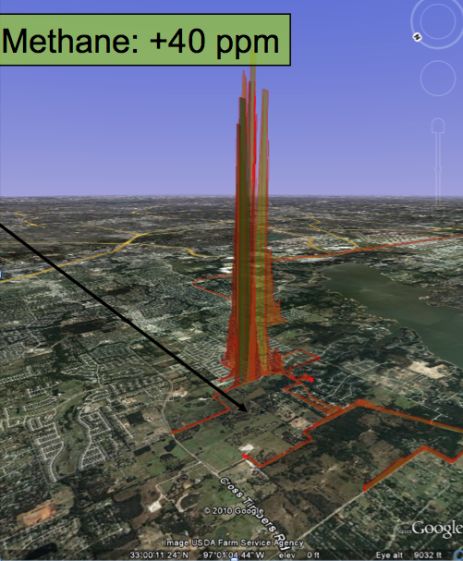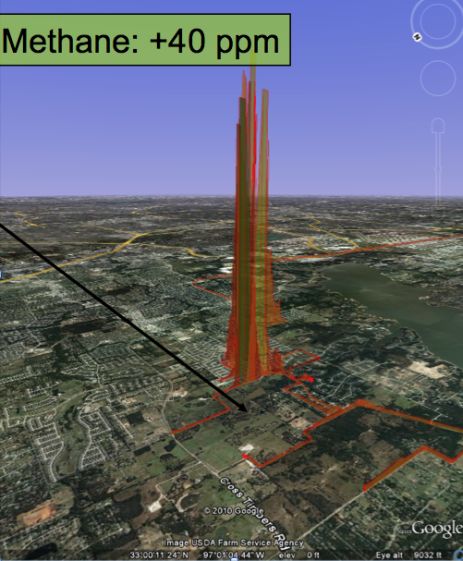If you had been driving through North Texas this week you might have seen a white Dodge Sprinter van circling some of the natural gas wells and compression stations that have sprung up around the Barnett Shale belt like boom-time subdivisions.
Drillers tap natural gas by splitting shale through a process called hydraulic fracturing, or fracking, that injects fluids laced with chemicals into the rock formations. The proliferation of shale gas drilling northeast of Dallas has ignited an uproar among residents, some of whom fear that fracking could be poisoning ground water and polluting the air with carcinogens. But the industry won’t disclose all the chemicals it uses and Texas environmental authorities won’t compel them to do so.
Which brings us back to our mystery van. Inside was a desktop computer-sized analyzer connected to a translucent tube that snaked out the roof of the van. The analyzer is made by a Silicon Valley company called Picarro and it provides real-time measurements of methane and other greenhouse gas emissions. By correlating the data with wind patterns, Picarro scientists can pinpoint the source of emissions. Oil and gas operations emit methane, which can also indicate the presence of benzene and other carcinogens, according to Picarro scientists.
 This is an image created by a mashup of the methane concentrations recorded by the Picarro analyzer in Flower Mound, Texas, overlaid on a Google map.A Picarro employee had driven the van to Texas from California at the request of Wilma Subra, a Louisiana scientist, environmental justice activist and MacArthur genius grant recipient. Picarro’s director of research and development, Chris Rella, flew to Texas and joined Subra and activists from Earthworks‘ Texas Oil & Gas Accountability Project on the hunt for fugitive emissions in the towns of DISH and Flower Mound.
This is an image created by a mashup of the methane concentrations recorded by the Picarro analyzer in Flower Mound, Texas, overlaid on a Google map.A Picarro employee had driven the van to Texas from California at the request of Wilma Subra, a Louisiana scientist, environmental justice activist and MacArthur genius grant recipient. Picarro’s director of research and development, Chris Rella, flew to Texas and joined Subra and activists from Earthworks‘ Texas Oil & Gas Accountability Project on the hunt for fugitive emissions in the towns of DISH and Flower Mound.
DISH — the name is capitalized because in 2005 the town changed its name in exchange for free satellite television from the DISH Network — is home to about 200 people and a dozen compression stations that push natural gas from wells into pipelines. As the Picarro van drove around DISH, concentrations of methane spiked from background concentrations of 1.8 parts per million to 20 parts per million near the compression stations. As the analyzer recorded the spikes they were automatically plotted on a Google map.
Twenty miles to the southeast in the Dallas exurb of Flower Mound, methane concentrations near natural gas wells literally went off the analyzer’s chart, topping 40 parts per million, says Subra and Picarro executives.
“I see this as very, very beneficial to the environmental justice movement,” says Subra. “It gives you real-time data and you can potentially identify the source as opposed to having to collect air samples and then have them analyzed. You can see the plume on the map and how close houses are to the compressor stations.”
(Last month, I took a ride in the same van with Rella to chart methane plumes from oil refineries in the San Francisco Bay Area. As atmospheric gases are drawn into the analyzer, laser beams are shot into an “optical cavity” in the machine. Methane and carbon molecules are absorbed at different wavelengths and the lasers measure the amount of absorption.)
Unlike other analyzers that require trained operators, the Picarro machine can run more-or-less on autopilot.
That ease of use and the machine’s ability to take stealthy and instantaneous measurements could prove to be a powerful tool for environmental justice activists pressing companies to disclose emissions of pollutants.
Once activists pinpointed the methane emissions in DISH and Flower Mound, they presented their findings to Texas environmental authorities. They also took air samples to be analyzed for other pollutants.
“We think the day will come sooner than most people realize when school kids can literally take an analyzer like ours and drive it around town,” Michael Woelk, Picarro’s chief executive, told me last month. “In a matter of hours they could put up online a Google map showing methane gas plumes and other plumes around their community and with that demand that something be done.”
Picarro, which licenses its core technology from Stanford University, has sold its $50,000 analyzers to the U.S. National Oceanic and Atmospheric Administration, the Chinese government and academic scientists. California is deploying the machines to create the world’s first statewide greenhouse gas monitoring network.
So why is the company making common cause with the environmental justice movement?
“We see a real market for our products,” says Alex Salkever, a Picarro spokesman. “We don’t see a lot of environmental justice groups buying $50,000 analyzers. But the EPA or another group could give grants for a library of analyzers that get lent out.”
Picarro made inroads with the activist community in January when company executives attended a U.S. Environmental Protection Agency environmental justice meeting in New Orleans. They met Subra and did a drive-around of Louisiana petrochemical plants to demonstrate the analyzer’s capabilities.
“Ultimately, we would be happy if natural gas companies buy our machines to know what’s going on with their facilities in real time,” says Salkever. “We see this as a market where we’ll be doing well by doing good.”
Environmental group Earthworks made this video of its stealth monitoring of methane emissions near natural gas compression stations in North Texas.



